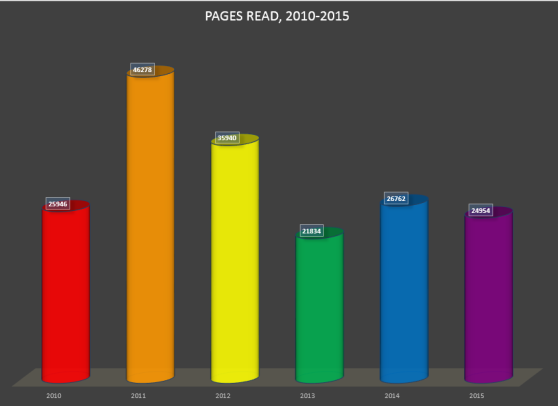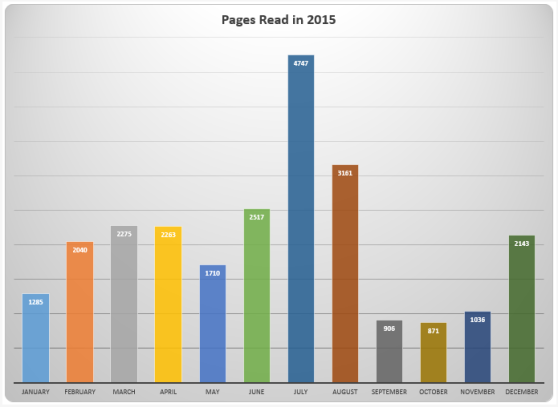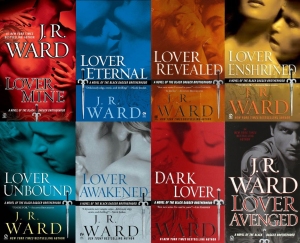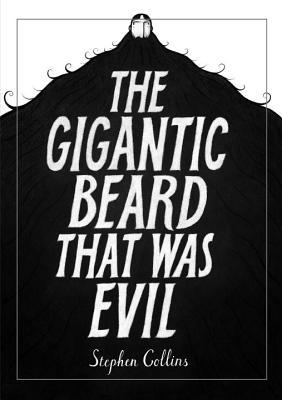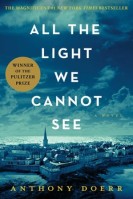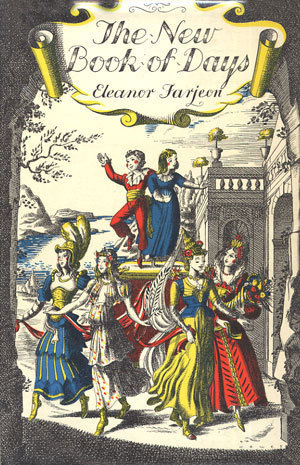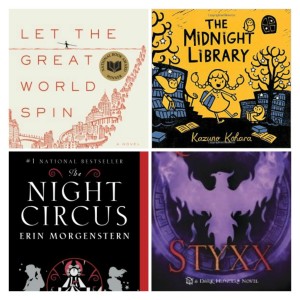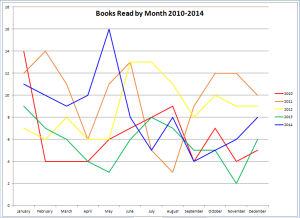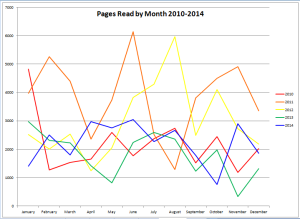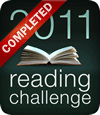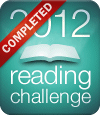It has been so long since I logged onto WordPress that I almost didn’t remember how to do it… oops… And here we are, with only 3 posts between this one and last year’s book roundup! Wow… Not sure whether I should pledge to do better, or just give up the ghost entirely… Anyway, it’s January 1 which means it is time for my annual “stats and charts about books” post… You can read old ones at 2015, 2014, 2013, 2012, 2011, and 2010.
 This hasn’t been a banner year for personal reading. Having a baby in January, and having a 3-year-old to boot, will do that to you. Picture books, though — we read LOTS of picture books. So many, in fact, that this morning I realized that I’d left two favorites off and had to go back and add them, putting me at 204% of my reading goal instead of the 200% I’d thought I would end at. I set a goal for 52 books and, once you add in the 49 picture books that stuck in my memory enough to be recorded, I more than doubled that goal. Of course, that means that less than half of the books I read this year had page counts in the triple-digits or intended reader age in the double-digits… But I’m pretty okay with that.
This hasn’t been a banner year for personal reading. Having a baby in January, and having a 3-year-old to boot, will do that to you. Picture books, though — we read LOTS of picture books. So many, in fact, that this morning I realized that I’d left two favorites off and had to go back and add them, putting me at 204% of my reading goal instead of the 200% I’d thought I would end at. I set a goal for 52 books and, once you add in the 49 picture books that stuck in my memory enough to be recorded, I more than doubled that goal. Of course, that means that less than half of the books I read this year had page counts in the triple-digits or intended reader age in the double-digits… But I’m pretty okay with that.
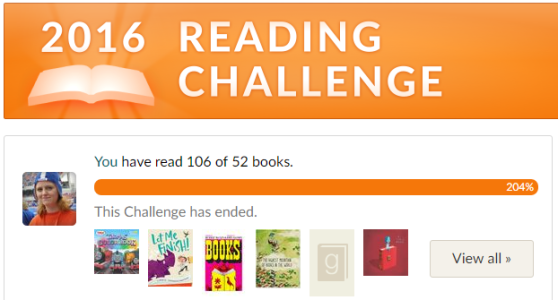
Here’s the genre breakdown, showing a disproportionate allocation of books for the 6-and-under crowd:

(To be completely accurate, a great many of those picture books were actually ones I read in two different batches while shopping for great new picture books to try to purchase for the school library.)
My genre identification is completely based on my own impression/opinion/perspective, and I tend to give a book no more than 4 labels (2 is better). With picture books I rarely add a more specific genre label unless they are nonfiction. When you look at the three largest wedges (excluding picture books) you should know that my preferred books tend to fall in all three of those categories — that is, the exact same books are represented by each of those three wedges.
Time to break it down by the months! I had some EXTREMELY weak months this year; October in particular was pretty laughable, with only 2 books and a total of 457 pages. The best month, if you focus only on the number of books, was June (I spent an afternoon binge-reading picture books) but February, when I was on maternity leave, wins with page count at 2,295.
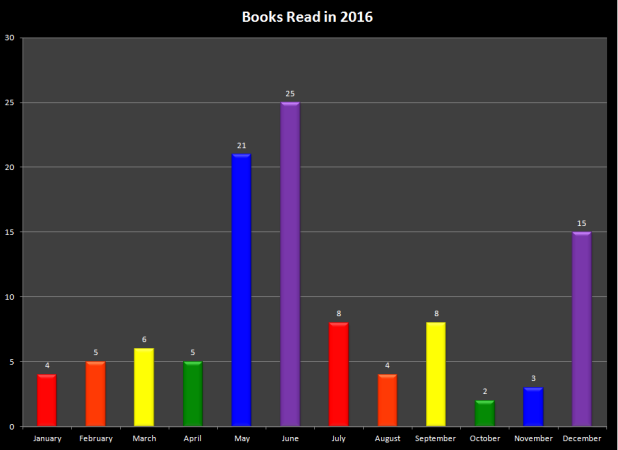

(Random side-note… in Excel my red and orange looked like distinct colors, but in WordPress they look almost identical. Oops. Sorry about that, those of you who care.)
This next graph highlights the disparity between book and page count so you can easily see the impact of a picture book-rich diet:
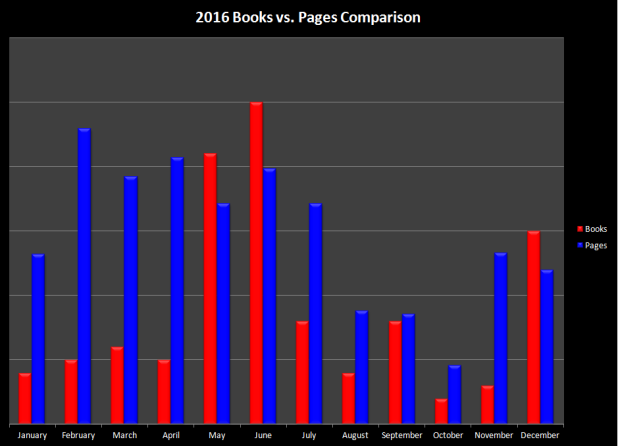
Ordinarily, the blue line should be considerably higher than the red line (design note: books are on a X100 scale). January through April show a normal distribution of books/pages. Then we get into May and June, where the red line is actually taller than the blue one — craziness! Lots of picture books those months.
It’s also instructive to examine the year’s reading in relationship to previous years. As you can see below, my total book level is well in line with past years.
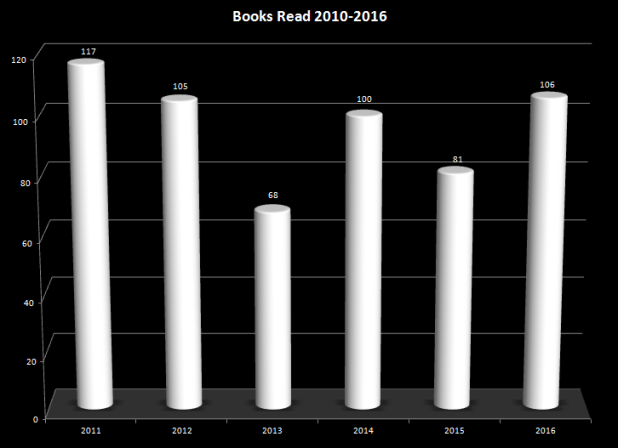
My page count, however… well, the graph speaks for itself:
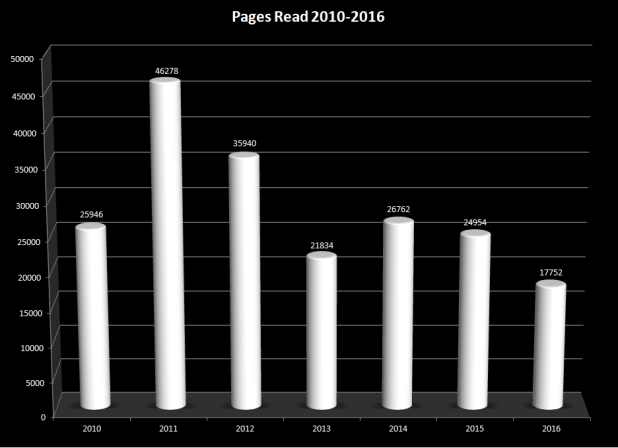
Lowest EVER. Hahaha… That said, some of the 32-page picture books I read this year were better than many 320-page novels I’ve read in my life!
So what were the 106 books I read this year, and which were the best?

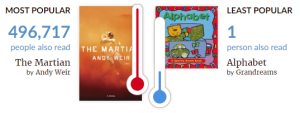 This year, Goodreads made a nifty little infographic thingy that, among other things, told me that the most popular book I read in 2016 was The Martian. It was definitely one of the better books of the year as well. I loved the author’s voice and the way he threaded the needle with the perfect amount of scientific detail.
This year, Goodreads made a nifty little infographic thingy that, among other things, told me that the most popular book I read in 2016 was The Martian. It was definitely one of the better books of the year as well. I loved the author’s voice and the way he threaded the needle with the perfect amount of scientific detail.
I also loved The Name of the Wind and am looking forward to reading the sequel, although I’m kind of dreading it because I know the final book in the trilogy is stalled.
At the Water’s Edge was a book club selection that I ended up liking quite a bit. Historical fiction with the Loch Ness Monster in it!
I also thoroughly enjoyed the graphic novel Phoebe and Her Unicorn and the latest installments in two YA/”new adult” series, Queen of Shadows and Court of Mist and Fury.
Which were my favorite picture books? The best ones came in my birthday present from my illustrator sister Meredith — a whole batch of beautiful books about books. It’s hard to go wrong with Oliver Jeffers/A Child of Books! But my very favorite picture book was the gorgeous and sentimental You Belong Here by M.H. Clark and Isabelle Arsenault. Definitely a “read to your little kids” favorite, but wonderful.
My worst two books of the year were MacRieve and Night Pleasures, neither of which were a pleasure. Bleh.
Oh, Goodreads also has this comparison to share:
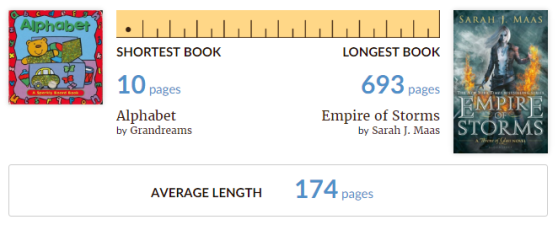
On dock, I’ve got Hounded (recommended by many trusted reader friends) and The Aeronaut’s Windlass (first in a series by the author of my favorite series) in addition to the aforementioned The Wise Man’s Fear (sequel to Name of the Wind). I’m also midway through the second book in the Phoebe/Unicorn series and a YA mystery novel called The Unfortunate Decisions of Dahlia Moss, which sadly hasn’t done much to hold my attention but deserves to be finished.
Well, I’ve got kids climbing on me, so I guess I’ll wrap this up. Did you read anything great last year? Looking forward to any particular books in 2017? Let me know!
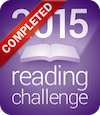 I’m going to go ahead and write my reading review before the new year this time, because I don’t have the slightest intention of finishing another book before 2016 rolls around. Aren’t you so happy? It’s like an early Christmas present, only it’s an early New Year’s present! That no one actually wants!
I’m going to go ahead and write my reading review before the new year this time, because I don’t have the slightest intention of finishing another book before 2016 rolls around. Aren’t you so happy? It’s like an early Christmas present, only it’s an early New Year’s present! That no one actually wants!
